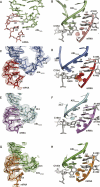Structures of tRNAs with an expanded anticodon loop in the decoding center of the 30S ribosomal subunit
- PMID: 17416634
- PMCID: PMC1869038
- DOI: 10.1261/rna.367307
Structures of tRNAs with an expanded anticodon loop in the decoding center of the 30S ribosomal subunit
Abstract
During translation, some +1 frameshift mRNA sites are decoded by frameshift suppressor tRNAs that contain an extra base in their anticodon loops. Similarly engineered tRNAs have been used to insert nonnatural amino acids into proteins. Here, we report crystal structures of two anticodon stem-loops (ASLs) from tRNAs known to facilitate +1 frameshifting bound to the 30S ribosomal subunit with their cognate mRNAs. ASL(CCCG) and ASL(ACCC) (5'-3' nomenclature) form unpredicted anticodon-codon interactions where the anticodon base 34 at the wobble position contacts either the fourth codon base or the third and fourth codon bases. In addition, we report the structure of ASL(ACGA) bound to the 30S ribosomal subunit with its cognate mRNA. The tRNA containing this ASL was previously shown to be unable to facilitate +1 frameshifting in competition with normal tRNAs (Hohsaka et al. 2001), and interestingly, it displays a normal anticodon-codon interaction. These structures show that the expanded anticodon loop of +1 frameshift promoting tRNAs are flexible enough to adopt conformations that allow three bases of the anticodon to span four bases of the mRNA. Therefore it appears that normal triplet pairing is not an absolute constraint of the decoding center.
Figures



Similar articles
-
A gripping tale of ribosomal frameshifting: extragenic suppressors of frameshift mutations spotlight P-site realignment.Microbiol Mol Biol Rev. 2009 Mar;73(1):178-210. doi: 10.1128/MMBR.00010-08. Microbiol Mol Biol Rev. 2009. PMID: 19258537 Free PMC article. Review.
-
Disruption of evolutionarily correlated tRNA elements impairs accurate decoding.Proc Natl Acad Sci U S A. 2020 Jul 14;117(28):16333-16338. doi: 10.1073/pnas.2004170117. Epub 2020 Jun 29. Proc Natl Acad Sci U S A. 2020. PMID: 32601241 Free PMC article.
-
Recognition of cognate transfer RNA by the 30S ribosomal subunit.Science. 2001 May 4;292(5518):897-902. doi: 10.1126/science.1060612. Science. 2001. PMID: 11340196
-
A new understanding of the decoding principle on the ribosome.Nature. 2012 Mar 21;484(7393):256-9. doi: 10.1038/nature10913. Nature. 2012. PMID: 22437501
-
Anticodon stem-loop tRNA modifications influence codon decoding and frame maintenance during translation.Semin Cell Dev Biol. 2024 Feb 15;154(Pt B):105-113. doi: 10.1016/j.semcdb.2023.06.003. Epub 2023 Jun 28. Semin Cell Dev Biol. 2024. PMID: 37385829 Free PMC article. Review.
Cited by
-
Structural Bases for the Fitness Cost of the Antibiotic-Resistance and Lethal Mutations at Position 1408 of 16S rRNA.Molecules. 2019 Dec 31;25(1):159. doi: 10.3390/molecules25010159. Molecules. 2019. PMID: 31906077 Free PMC article.
-
Visualization of two transfer RNAs trapped in transit during elongation factor G-mediated translocation.Proc Natl Acad Sci U S A. 2013 Dec 24;110(52):20964-9. doi: 10.1073/pnas.1320387110. Epub 2013 Dec 9. Proc Natl Acad Sci U S A. 2013. PMID: 24324168 Free PMC article.
-
A gripping tale of ribosomal frameshifting: extragenic suppressors of frameshift mutations spotlight P-site realignment.Microbiol Mol Biol Rev. 2009 Mar;73(1):178-210. doi: 10.1128/MMBR.00010-08. Microbiol Mol Biol Rev. 2009. PMID: 19258537 Free PMC article. Review.
-
Genome Expansion by tRNA +1 Frameshifting at Quadruplet Codons.J Mol Biol. 2022 Apr 30;434(8):167440. doi: 10.1016/j.jmb.2021.167440. Epub 2022 Jan 4. J Mol Biol. 2022. PMID: 34995554 Free PMC article. Review.
-
Mechanism of tRNA-mediated +1 ribosomal frameshifting.Proc Natl Acad Sci U S A. 2018 Oct 30;115(44):11226-11231. doi: 10.1073/pnas.1809319115. Epub 2018 Sep 27. Proc Natl Acad Sci U S A. 2018. PMID: 30262649 Free PMC article.
References
-
- Brünger, A.T., Adams, P.D., Clove, G.M., Delano, W.L., Gros, P., Grosse-Kunstleve, R.W., Jiang, J.-S., Kuszewski, J., Nilges, M., Pannu, N.S., et al. Crystallography and NMR system: A new software suite for macromolecular structure determination. Acta Crystallogr. D Biol. Crystallogr. 1998;54:905–921. - PubMed
-
- Carter, A.P., Clemons, W.M., Brodersen, D.E., Morgan-Warren, R.J., Wimberly, B.T., Ramakrishnan, V. Functional insights from the structure of the 30S ribosomal subunit and its interactions with antibiotics. Nature. 2000;407:340–348. - PubMed
-
- CCP4. The CCP4 suite: Programs for protein crystallography. Acta Crystallogr. D Biol. Crystallogr. 1994;50:760–763. - PubMed
-
- Clemons W.M., Jr, Brodersen, D.E., McCutcheon, J.P., May, J.L., Carter, A.P., Morgan-Warren, R.J., Wimberly, B.T., Ramakrishnan, V. Crystal structure of the 30S ribosomal subunit from Thermus thermophilus: Purification, crystallization, and structure determination. J. Mol. Biol. 2001;310:827–843. - PubMed
Publication types
MeSH terms
Substances
Grants and funding
LinkOut - more resources
Full Text Sources
